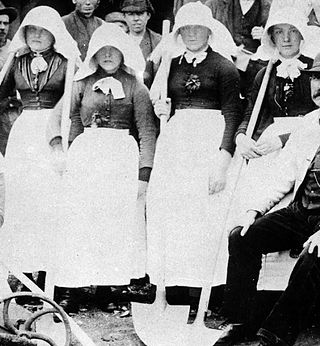
Stannary law is the body of English law that governs tin mining in Cornwall and Devon; although no longer of much practical relevance, the stannary law remains part of the law of the United Kingdom and is arguably the oldest law incorporated into the English legal system.

The tin mining industry on Dartmoor, Devon, England, is thought to have originated in pre-Roman times, and continued right through to the 20th century, when the last commercially worked mine closed in November 1930. From the 12th century onwards tin mining was regulated by a stannary parliament which had its own laws.

The history of Cornwall goes back to the Paleolithic, but in this period Cornwall only had sporadic visits by groups of humans. Continuous occupation started around 10,000 years ago after the end of the last ice age. When recorded history started in the first century BCE, the spoken language was Common Brittonic, and that would develop into Southwestern Brittonic and then the Cornish language. Cornwall was part of the territory of the tribe of the Dumnonii that included modern-day Devon and parts of Somerset. After a period of Roman rule, Cornwall reverted to rule by independent Romano-British leaders and continued to have a close relationship with Brittany and Wales as well as southern Ireland, which neighboured across the Celtic Sea. After the collapse of Dumnonia, the remaining territory of Cornwall came into conflict with neighbouring Wessex.

Devon is a county in south west England, bordering Cornwall to the west with Dorset and Somerset to the east. There is evidence of occupation in the county from Stone Age times onward. Its recorded history starts in the Roman period when it was a civitas. It was then a separate kingdom for a number of centuries until it was incorporated into early England. It has remained a largely agriculture based region ever since though tourism is now very important.

The constitutional status of Cornwall has been a matter of debate and dispute. Cornwall is an administrative county of England.
A stannary was an administrative division established under stannary law in the English counties of Cornwall and Devon to manage the collection of tin coinage, which was the duty payable on the metal tin smelted from the ore cassiterite mined in the region. In Cornwall, the duty was passed to the Duchy of Cornwall; in Devon to the Crown.
Toll tin or tin toll was a toll payable in tin mining in Devon and Cornwall in south-west England. The holder of a set of tin bounds was required to pay the freeholder of the land on which the bounds had been pitched a portion, called toll tin, of the tin ore extracted.
Mining setts were a legal arrangement used historically in the counties of Devon and Cornwall in South West England to manage the exploitation of land for the extraction of tin. The term was also used on the Isle of Man.
Farm tin or the tin dues was one of a number of payments required of tin miners in Devon and Cornwall. The holder of a mining sett was required to pay a portion of the black tin extracted to the holder of the tin bounds in which the sett was granted. The portion was the "farm tin". The portion was normally interpreted to be one-twelfth of extracted tin: they were also required to play toll tin, calculated at one fifteenth.

Geevor Tin Mine, formerly North Levant Mine is a tin mine in the far west of Cornwall, England, between the villages of Pendeen and Trewellard. It was operational between 1911 and 1990 during which time it produced about 50,000 tons of black tin. It is now a museum and heritage centre left as a living history of a working tin mine. The museum is an Anchor Point of ERIH, The European Route of Industrial Heritage. Since 2006, the mine has been part of the UNESCO World Heritage Site Cornwall and West Devon Mining Landscape.

Mining in Cornwall and Devon, in the southwest of Britain, is thought to have begun in the early-middle Bronze Age with the exploitation of cassiterite. Tin, and later copper, were the most commonly extracted metals. Some tin mining continued long after the mining of other metals had become unprofitable, but ended in the late 20th century. In 2021, it was announced that a new mine was extracting battery-grade lithium carbonate, more than 20 years after the closure of the last South Crofty tin mine in Cornwall in 1998.

Lydford Castle is a medieval castle in the town of Lydford, Devon, England. The first castle in Lydford, sometimes termed the Norman fort, was a small ringwork built in a corner of the Anglo-Saxon fortified burh in the years after the Norman conquest of England. It was intended to help control Devon following the widespread revolt against Norman rule in 1068. The Norman fort had been abandoned by the middle of the 12th century.

Gwennap is a village and civil parish in Cornwall, England, United Kingdom. It is about five miles (8 km) southeast of Redruth. Hamlets of Burncoose, Comford, Coombe, Crofthandy, Cusgarne, Fernsplatt, Frogpool, Hick's Mill, Tresamble and United Downs lie in the parish, as does Little Beside country house.
Poldark Mine is a tourist attraction near the town of Helston in Cornwall, England, UK. It lies within the Wendron Mining District of the Cornwall and West Devon Mining Landscape World Heritage Site. Its features include underground guided tours through ancient tin mine workings; a museum of industrial heritage, mining equipment and Cornish social history; and a scheduled ancient monument and riverside gardens.

A bal maiden, from the Cornish language bal, a mine, and the English "maiden", a young or unmarried woman, was a female manual labourer working in the mining industries of Cornwall and western Devon, at the south-western extremity of Great Britain. The term has been in use since at least the early 18th century. At least 55,000 women and girls worked as bal maidens, and the actual number is likely to have been much higher.

Birch Tor and Vitifer mine was a tin mine on Dartmoor, Devon, England. Located in the valley of the Redwater Brook, to the east of the B3212 Moretonhampstead to Princetown road, below the Warren House Inn, the mine was worked between the mid–18th century and 1925.

The Ding Dong mines lie in an old and extensive mining area in the parish of Madron, in Penwith, Cornwall, England. They are about two miles north east of the St Just to Penzance road and look over Mount's Bay and St Michael's Mount to the south west. Since 2006 the site has been a UNESCO World Heritage Site, part of Cornwall and West Devon Mining Landscape.
Wheal Fortune or Great Wheal Fortune is the site of a mine in the civil parishes of Breage and Sithney in west Cornwall. Part of the disused mine was designated as a Site of Special Scientific Interest (SSSI) for its geological interest in 1991 and is also a Geological Conservation Review site of national importance for the minerals on the site.

Devon Great Consols was a copper mine near Tavistock in Devon. The lease on the site was taken from the Duke of Bedford in 1844 by a group of investors, Sanderson & Co., that included the father of William Morris. The 1,024 shares, sold at one pound each, were divided among the six men. Earlier attempts to mine this property had all ended in failure.
The Stannary Convocation of Devon, also known as the Great Parliament of the Tinners or as the Devon Stannary Parliament, was an assembly in the English county of Devon, with the power to amend and expand the stannary law in the county. Initially assembled in the Middle Ages by the Lord Warden of the Stannaries, the Stannary Convocation developed out of the predecessor to the judicial Courts of the Vice-Warden of the Stannaries but was established as an institution in its own right by the sixteenth century, with the power to both proclaim the existing customs as English law and to legislate regarding the laws by which tinners, who were exempt from the jurisdiction of the ordinary English courts until 1896, conducted their business.











